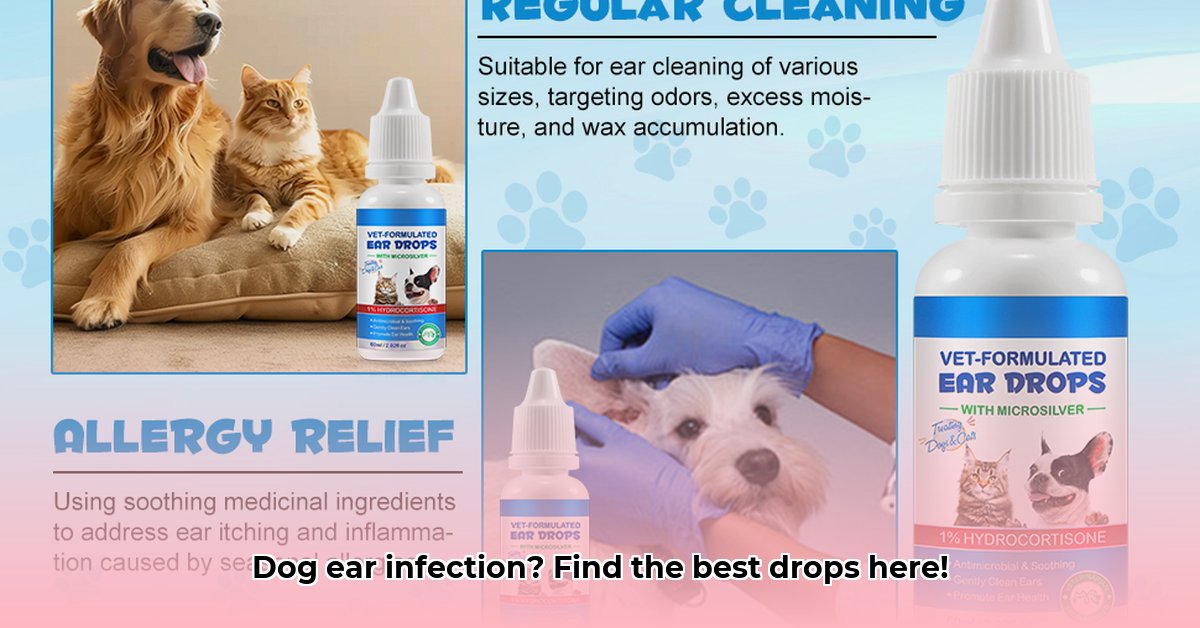Is your dog showing signs of ear discomfort? Itchy, smelly ears, or unusual discharge? These are common indicators of a potential ear infection in dogs. For more on canine health concerns, you might find this article helpful: Dog Health Concerns. This comprehensive guide provides essential information about dog ear infections, covering causes, safe cleaning methods, medication application, and effective preventive measures. We’ll explore veterinary recommendations, proper ear care techniques, and identify situations requiring immediate veterinary attention.
Dog Ear Infection Drops: A Comprehensive Guide to Treatment and Prevention
Dog ear infections can be a source of frustration for both you and your canine companion. Observing your dog incessantly shaking their head, scratching their ears, or struggling with smelly discharge can be disheartening. Understanding the intricacies of ear infections and their effective treatment is crucial for restoring your dog’s health and overall well-being. This guide offers a detailed overview, from recognizing early warning signs to implementing strategies for preventing future occurrences. Please remember that the information contained within this guide is intended for educational purposes only and should never substitute professional veterinary advice.
Understanding Canine Ear Infections: What’s Going On?
Dog ear infections, clinically referred to as otitis, are extremely prevalent, affecting approximately 20% of dogs at some point in their lives. These infections frequently arise due to imbalances in the naturally occurring bacteria or yeast populations within the ear canal. Factors such as allergies, certain anatomical features (particularly floppy ears), and environmental conditions can significantly increase a dog’s susceptibility to ear infections. These infections can manifest in the outer ear (otitis externa), middle ear (otitis media), or inner ear (otitis interna), each presenting its own distinct set of complications and requiring specific treatment approaches.
Common symptoms of ear infections in dogs include:
- Frequent head shaking or tilting
- Persistent scratching or pawing at the ears
- Redness or swelling of the ear canal or flap
- Dark discharge or an unusual odor emanating from the ear
- Crusting or scabs in or around the ears
- Visible discomfort when the ears are touched
- Walking in circles or exhibiting a loss of balance
- Hearing difficulties or unresponsiveness to sounds
Early detection of these signs is paramount for ensuring timely intervention and preventing the infection from progressing to more severe stages.
Diagnosing the Problem: The Importance of a Vet Visit
While you might be tempted to explore home remedies, an accurate diagnosis necessitates a professional veterinary assessment. A veterinarian possesses the expertise and diagnostic tools to differentiate between bacterial, yeast, or more complex infections involving multiple pathogens. Attempting to treat an ear infection without a proper diagnosis can not only worsen the condition but also potentially lead to serious complications, such as chronic inflammation, hearing loss, or even neurological damage.
During a veterinary examination, the veterinarian will typically use an otoscope to thoroughly examine the ear canal, looking for signs of inflammation, discharge, and foreign bodies. They may also collect samples of earwax and discharge for microscopic examination or culture to identify the specific causative agent, whether it’s bacteria, yeast, or ear mites. This targeted approach ensures that the treatment plan is tailored to address the underlying cause of the infection.
Treatment Options: Leveraging Veterinary Expertise
Based on the diagnosis, your veterinarian will formulate a tailored treatment plan to address the specific type and severity of the ear infection. This plan may encompass a combination of treatment modalities, including:
- Antibiotic ear drops: Prescribed to combat bacterial infections by directly targeting the bacteria present in the ear canal.
- Antifungal ear drops: Formulated to treat yeast infections by inhibiting the growth and proliferation of yeast organisms.
- Combination ear drops: Contain a combination of antibacterial, antifungal, and anti-inflammatory agents to address mixed infections or cases where the causative agent is uncertain.
- Oral medications: Administered systemically to treat severe or deep-seated infections that have spread beyond the ear canal, or when topical treatments are insufficient.
- Ear cleaning solutions: Used to remove debris, wax, and discharge from the ear canal, creating a cleaner environment for medications to penetrate effectively.
The specific choice of treatment will depend on the type of infection, the severity of the symptoms, and your dog’s overall health status. In some cases, a culture and sensitivity test may be performed to identify the specific microorganisms involved and determine their susceptibility to various antibiotics or antifungals, ensuring the most effective treatment is selected.
Below is an overview of common treatment options:
| Treatment Type | Pros | Cons |
|---|---|---|
| Antibiotic Ear Drops | Directly targets bacterial infections; often effective in resolving localized infections. | May not be effective against yeast; potential for antibiotic resistance with overuse; may not reach deep-seated infections. |
| Antifungal Ear Drops | Specifically combats yeast infections; helps restore balance in the ear canal. | Ineffective against bacterial infections; may require prolonged treatment for complete resolution. |
| Combination Therapy | Addresses both bacterial and yeast infections; reduces inflammation and discomfort. | Can be more expensive; potential for drug interactions or side effects; requires careful monitoring. |
| Oral Medications | Systemic treatment; reaches deeper infections; effective for severe or widespread infections. | Potential for more widespread side effects, such as gastrointestinal upset; may require longer treatment duration. |
| Medicated Ear Cleaners | Helps remove debris and wax; creates a cleaner environment for medications to work effectively. | May cause irritation if used too frequently or improperly; some dogs may find the cleaning process stressful. |
Selecting the most appropriate treatment strategy requires the expertise and judgment of a qualified veterinarian, who can assess your dog’s individual needs and tailor the treatment plan accordingly.
Applying Dog Ear Infection Drops: A Step-by-Step Guide
When administering medication, precise application is of utmost importance to ensure optimal efficacy and minimize the risk of complications. Always adhere to your veterinarian’s specific instructions regarding dosage, frequency, and duration of treatment.
- Warm it up: Gently warm the ear drops to room temperature by holding the bottle in your hands for a few minutes. This helps prevent startling your dog and makes the application process more comfortable.
- Clean the ear canal: Before applying the medication, thoroughly clean the ear canal using a vet-recommended ear cleaner to remove any visible debris, wax, or discharge. Avoid using cotton swabs, as they can push dirt and debris further into the ear canal, potentially exacerbating the infection; instead, use a soft cloth or cotton ball to gently wipe the outer ear.
- Hold steady: Gently but firmly hold your dog’s ear flap upright to ensure proper placement of the drops. Enlist the assistance of another person if your dog is resistant or uncooperative.
- Administer: Carefully squeeze the prescribed amount of drops into the ear canal as directed by your veterinarian. Avoid touching the tip of the applicator to the ear to prevent contamination.
- Massage gently: Gently massage the base of the ear for approximately 30 seconds to help distribute the medication throughout the ear canal and ensure adequate absorption.
If you are unsure about any aspect of the application process, do not hesitate to seek clarification from your veterinarian.
Ear Cleaning Techniques: Maintaining Optimal Ear Hygiene
Regular ear cleaning plays a crucial role in preventing future ear infections and maintaining optimal ear hygiene in dogs, especially those prone to ear problems. Your veterinarian can recommend a suitable ear cleaner formulated specifically for dogs and demonstrate the most effective and safe method for cleaning your dog’s ears without causing harm or irritation.
Avoid over-cleaning, as excessive cleaning can disrupt the natural balance of the ear canal and make it more susceptible to infection. Aim for a gentle and consistent approach, cleaning the ears as needed based on your dog’s individual needs and lifestyle.
Preventing Future Infections: Emphasizing Proactive Care
Preventing ear infections is far more desirable than treating them, and implementing proactive care measures can significantly reduce your dog’s risk of developing ear problems. Consider the following preventive strategies:
- Regular vet checkups: Schedule regular veterinary examinations to detect potential problems early and monitor your dog’s overall health.
- Address allergies: Allergies are a common trigger for ear infections in dogs, so work closely with your veterinarian to identify and manage any underlying allergies.
- Keep ears dry and clean: Moisture creates a breeding ground for bacteria and yeast, so it’s essential to keep your dog’s ears dry and clean, especially after bathing or swimming. Gently wipe away excess moisture with a soft cloth or cotton ball.
- Inspect regularly: Make it a habit to regularly inspect your dog’s ears for any signs of redness, swelling, unusual discharge, or foul odor. Early detection allows for prompt intervention and prevents the infection from progressing.
When to Seek Immediate Veterinary Attention
Seek immediate veterinary intervention if your dog exhibits any of the following signs:
- Severe pain: Your dog displays signs of intense discomfort, such as whimpering, reluctance to be touched, or aggression when the ears are handled.
- Significant swelling: Noticeable inflammation or swelling in or around the ear, indicating a severe infection or abscess.
- Pus or bloody discharge: Discharge that is thick, discolored, or contains blood may indicate a serious infection requiring immediate treatment.
- Balance problems or head tilt: These signs could signal inner ear involvement, which can have serious neurological consequences if left untreated.
Early diagnosis and treatment are paramount for alleviating your dog’s discomfort, preventing long-term complications, and restoring
- The Best Bento Box Price For Your Perfect Packed Lunch - December 15, 2025
- Bento Box Shopping Tips for Smart and Stylish Lunch Prep - December 14, 2025
- Bento Box Trays Streamline Restaurant Meal Presentation and Transport - December 13, 2025










